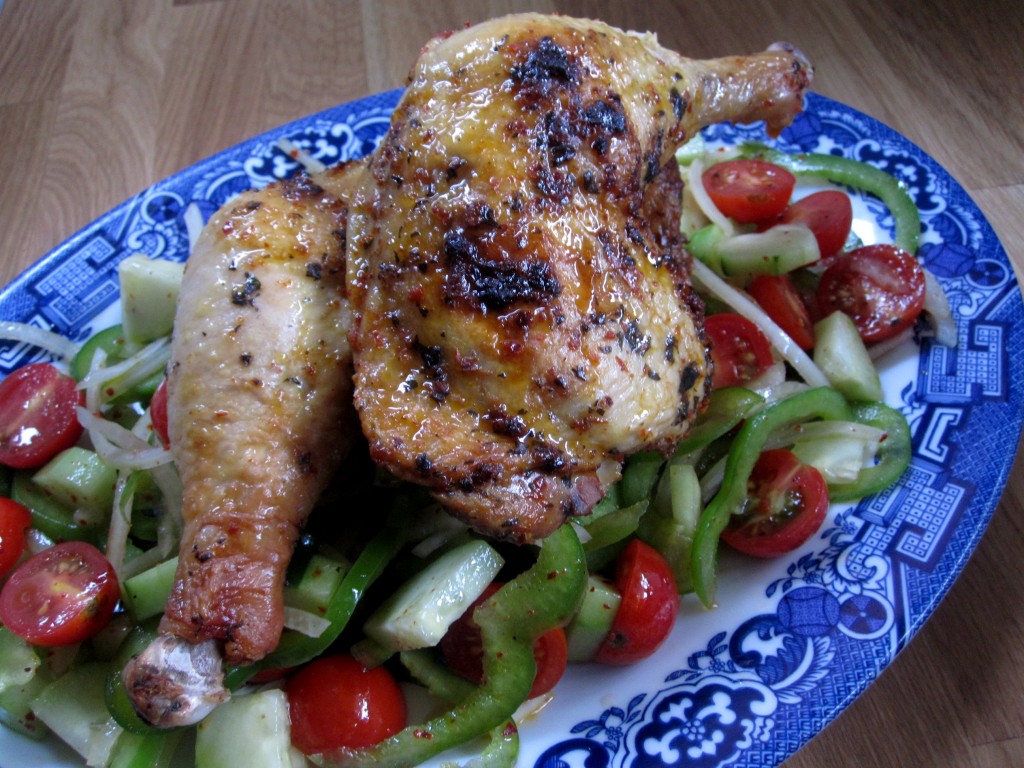I threw together this simple marinade the other morning, let it sit with some lovely pastured chicken legs all day, and then roasted them up for dinner night. The legs came out incredibly juicy and delicious. So good, in fact, that I wondered just what I had done to deserve such great flavor out of such a simple recipe. But I knew what I had done right – I had followed the basic rules for creating a marinade and had allowed adequate time for the meat to marinate.
So what are my rules for creating a great marinade? You only need to remember three things: oil, acid, and flavor. Ratios are important in a marinade, but only very generally. You’ll need slightly more acid then oil (about 1/3 oil to 2/3 acid – more on that later), but flavorings are limited only by your imagination.
Some common ingredient choices for marinades:
Oil: Any oil that is liquid at room temperature will work well. As you probably know, I avoid “vegetable oils” due to their excessively high omega-6 content. Some of my favorite non-vegetable oils for marinades are olive, sesame, walnut, and avocado oils.
Acid: Fresh squeezed lemon, lime, or orange juice, vinegar of any kind (sherry vinegar and apple cider vinegar are my favorites), wine, yogurt, tomato, etc.
Flavorings: Garlic, red onion, shallots, ginger, chiles, citrus zest, rosemary, oregano, cilantro, or any fresh herb that you like, any number of spices (garam masala, turmeric, cumin, coriander, and smoked or sweet paprika are some of my favorites), SALT, and on and on.
When making your marinade, begin with your oil and acid, remembering the 1/3 oil, 2/3 acid ratio. If you’re using something less acidic as your primary acidic ingredient (oranges, wine, or yogurt for example), I recommend including a little bit of a more strongly acidic component to ensure the most tender and flavorful result (for example avocado oil + orange (less acidic) + lime (more acidic) + smoked paprika + salt). After all, the acid in a marinade is what works to break down and tenderize the meat, paving the way for the flavorings you choose to really get in there.
Now you can add your flavorings and the last very important component, plenty of salt. When salting your marinade, think about how much salt you would use to season the amount of meat that you have, and then double it. This is a good idea because what’s left of your marinade will be thrown away (along with a lot of the salt) before cooking.
So without further ado, here is my recipe Syrian Roasted Chicken, made with a marinade of olive oil, lemon, oregano, and Aleppo pepper.
Syrian Roasted Chicken:
*serves 4*
3 Tbsp. olive oil
zest and juice of 1 lemon (about 1 Tbsp. zest and ¼ C. juice)
3 Tbsp. chopped, fresh oregano
1 Tbsp. Aleppo Pepper
2 tsp. sea salt
4 whole chicken legs
Whiz up the marinade ingredients in a blender or whisk them together in a bowl until well incorporated. Pour the marinade over the chicken legs in a container just large enough to hold the meat in a single layer (a Ziploc bag is another fine idea). Allow the chicken to marinate for at least four hours or up to 24 hours.
When you’re ready to roast your chicken, remove if from the fridge while you preheat the oven to 375 degrees. Transfer the chicken to a large sheet pan or baking dish, discarding all of the extra marinade. Be sure the chicken pieces are at least an inch apart from each other during roasting to ensure they come out crispy.
Roast the chicken for about 35 minutes, or until the legs reach 165 degrees in the middle. Serve the legs over a simple Middle Eastern vegetable salad dressed with more olive oil and lemon, as pictured here. Delicious!




 RSS - Posts
RSS - Posts